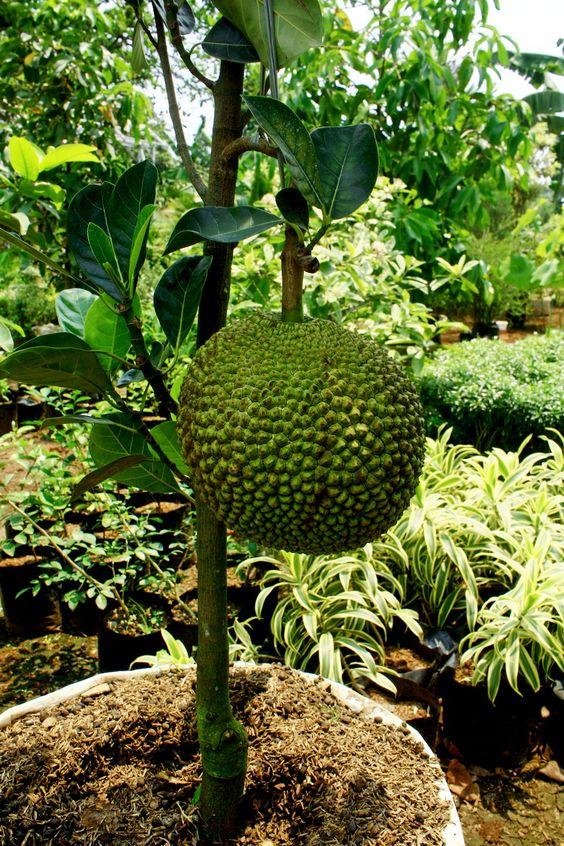how to grow jackfruit in a pot – [Beginners Guide]
Are you looking for a unique and exotic fruit to grow in a pot at home? Look no further than jackfruit! This tropical fruit is not only delicious but also makes for an excellent addition to your home garden. As someone who has successfully grown jackfruit in a pot, I can attest to the convenience and satisfaction of harvesting your own fresh fruit.
One of the great advantages of growing jackfruit in a pot is that it allows you to enjoy this delicious fruit even if you don’t have a large garden or live in a tropical climate. By using a pot, you can easily control the growing environment, ensuring that your plant has the right amount of sunlight, water, and nutrients to thrive.
In this guide, we’ll go over all the steps you need to take to grow jackfruit in a pot successfully. We’ll cover everything from choosing the right type of pot and soil to selecting the perfect location and caring for your plant as it grows. We’ll also address common issues you may face and provide tips on how to overcome them.
So, whether you’re an experienced gardener or a novice looking to try something new, growing jackfruit in a pot is an exciting and rewarding venture. Let’s dive in and explore how you can get started today!
Pot or container selection
Growing jackfruit in a pot is a great way to enjoy this tropical fruit even if you don’t live in a warm climate. When selecting a pot for your jackfruit, there are a few important factors to consider to ensure optimal growth.
Firstly, size and capacity are essential. Jackfruit trees can grow up to 80 feet tall in their native environment, but they can be pruned to a smaller size when grown in pots. Aim for a pot that is at least 24 inches (60 cm) in diameter and 24 inches (60 cm) deep. This will allow enough space for the plant to grow and produce fruit.
It’s also crucial to choose a pot that is made of a durable material, such as plastic, fiberglass, or ceramic. Avoid pots made of metal or wood, as they can rot over time or leach chemicals into the soil. Additionally, ensure that your pot has drainage holes in the bottom to allow excess water to drain out. If your pot doesn’t have drainage holes, drill some yourself or add a layer of rocks or gravel to the bottom to help with drainage.
Lastly, it’s essential to choose a pot that is suitable for the size of your plant. Avoid using oversized pots, as this can lead to waterlogging and root rot. On the other hand, using a pot that is too small can stunt growth and reduce fruit production.
In summary, when selecting a pot for your jackfruit, aim for a durable pot with drainage holes that is at least 24 inches (60 cm) in diameter and 24 inches (60 cm) deep. By choosing the right pot, you can give your jackfruit the best chance at thriving and producing a bountiful harvest.
Make suitable soil mix
When it comes to growing jackfruit in a pot, soil composition is just as important as pot size and construction. Jackfruit trees prefer a rich, well-draining soil mix that is slightly acidic. Here are some things to consider when selecting soil for your jackfruit tree:
Type and Mixture
It’s best to use a high-quality potting mix that is specifically formulated for fruit trees. These mixes are typically made from a combination of peat moss, perlite, vermiculite, and organic matter, which provide the right balance of nutrients and drainage for your jackfruit tree.
In addition to a good quality potting mix, you may also want to consider adding some amendments to your soil to give your jackfruit tree a boost. Some options include:
- Compost: Adding compost to your soil can help improve its structure, drainage, and nutrient content.
- Organic fertilizers: You can use organic fertilizers, such as bone meal or blood meal, to provide additional nutrients for your jackfruit tree.
- pH adjusters: Jackfruit trees prefer a slightly acidic soil pH (between 5.5 and 7.0). You can use sulfur or aluminum sulfate to lower the pH of your soil, or lime to raise it.
By choosing the right soil mix and adding the right amendments, you can create a healthy and fertile environment for your jackfruit tree to thrive in. Remember to also ensure proper drainage in your pot, as waterlogged soil can cause root rot and other issues. With the right care and attention, you can enjoy a bountiful harvest of fresh and delicious jackfruit right in your own home.
How to plant the jackfruit?
Growing jackfruit in a pot at home is a great way to enjoy this tropical fruit without needing a lot of space. Here’s a step-by-step guide to planting jackfruit in a pot:
Step 1: Choose the right pot
Choose a pot that is at least 18 inches in diameter and depth to accommodate the large root system of a jackfruit tree. Make sure the pot has good drainage holes at the bottom.
Step 2: Prepare the soil mix
Prepare a soil mix that is well-draining and rich in nutrients. A mix of 1 part peat moss, 1 part perlite, and 1 part organic compost works well for jackfruit.
Step 3: Plant the jackfruit tree
Fill the pot with the soil mix and make a hole in the center. Place the jackfruit sapling in the hole, ensuring the root ball is level with the soil surface. Fill in around the roots with soil, tamping it down to remove any air pockets.
Step 4: Water and fertilize
Water the tree deeply after planting to help settle the soil around the roots. Water the tree regularly to keep the soil consistently moist, but not waterlogged. Use a balanced fertilizer, such as 10-10-10 or 20-20-20, every two months to help the tree grow and produce fruit.
Step 5: Provide support
As the jackfruit tree grows, it may need support to prevent it from falling over. You can use a stake or a trellis to support the tree. Place the support in the pot before the tree grows too large to avoid damaging the roots.
Step 6: Provide adequate light and warmth
Jackfruit trees need full sun and warm temperatures to thrive. Place the pot in a sunny location, such as a south-facing window or on a sunny patio. Keep the temperature around the tree between 60°F and 85°F.
By following these steps, you can successfully grow a jackfruit tree in a pot at home and enjoy the delicious fruit it produces.
How to care for jackfruit?
Watering Requirement
When growing jackfruit in a pot, it’s important to water the plant regularly, but not too much. Overwatering can lead to root rot, while underwatering can cause the plant to wilt and the fruit to be less flavorful. Water the plant deeply once a week, and adjust the frequency based on the weather and the size of the pot. Check the soil moisture level by sticking your finger about an inch into the soil. If it feels dry at that depth, it’s time to water. Make sure the pot has drainage holes to allow excess water to drain away from the roots.
Fertilizer Requirement
Jackfruit plants benefit from a regular supply of nutrients, especially when grown in a pot. Use a balanced fertilizer, such as a 10-10-10 formula, according to the package directions. Alternatively, you can use a slow-release fertilizer or compost to provide a steady supply of nutrients over time. Avoid overfertilizing, as this can lead to excessive foliage growth at the expense of fruit production.
Sunlight Needs
Jackfruit plants require full sun to grow and produce fruit. Choose a spot in your home or on your patio that gets at least 6 hours of direct sunlight per day. If you live in a cooler climate, consider moving the pot to a warm location or using a grow light to provide additional light.
Pruning & Training
Pruning and training jackfruit plants can help improve air circulation, increase sun exposure, and make harvesting easier. To prune, simply remove any dead, diseased, or damaged branches. To train your jackfruit plants, use stakes or trellises to support the plants as they grow. This will help prevent them from falling over and will make it easier to access the fruit. Additionally, you can remove any suckers that grow from the base of the plant to focus the plant’s energy on producing fruit.
Other Care
In addition to watering, fertilizing, and pruning, there are a few other things you can do to care for your jackfruit plant:
- Mulch the soil around the plant to help retain moisture and suppress weeds.
- Monitor the plant for pests and diseases. Common problems include mealybugs, scale insects, and fungal diseases. If you notice any issues, take action immediately to prevent them from spreading.
- During hot and dry weather, mist the leaves of the plant to increase humidity and prevent leaf drop.
- As the plant grows, you may need to repot it into a larger container to accommodate the root system. Repotting is best done in the spring or fall.
With a little care and attention, your jackfruit plant will thrive and reward you with delicious fruit.
Common problems
Other Issues
Aside from pests, insects, diseases, and poor production, there are other issues that jackfruit grown in pots may face:
Root-bound: Jackfruit can become root-bound if they outgrow their pot, which means their roots become tangled and compacted, leading to poor growth and yield. To prevent this, it’s important to choose a pot that is large enough for the size of your jackfruit and to repot it every few years.
Lack of pollination: Jackfruit plants need to be pollinated in order to produce fruit. If you’re growing your jackfruit indoors or in an area with no natural pollinators, such as bees, you may need to manually pollinate the flowers using a small brush.
Environmental factors: Jackfruit plants are sensitive to extreme temperatures, both hot and cold. They also need a lot of humidity to grow well. If you’re growing your jackfruit in a pot, make sure it’s in a location with consistent temperature and humidity levels.
Nutrient deficiency: Jackfruit plants require a balanced supply of nutrients, including nitrogen, phosphorus, and potassium. If your plant is showing signs of nutrient deficiency, such as yellow leaves, stunted growth, or poor fruit development, it may be time to fertilize it or add compost to the soil.
Overall, caring for jackfruit grown in pots involves providing them with adequate sunlight, water, nutrients, and protection from pests, insects, diseases, and environmental factors. With proper care and attention, your jackfruit can thrive and produce a bountiful harvest.
Harvesting & storing homegrown jackfruit
Jackfruit is a tropical fruit that is usually harvested when it is mature and ready to eat. Here are some tips on how to know when to harvest and store your homegrown jackfruit:
When to Harvest Jackfruit
Jackfruit is typically ready for harvest when the fruit has a strong aroma, and the spikes or knobs on its skin start to soften. Another way to tell if the fruit is ready for harvest is by tapping it. If the fruit sounds hollow, it is probably ripe and ready to be picked.
It is important to note that jackfruit should not be left on the tree for too long, as it will eventually fall and may become overripe or damaged. Once you determine that the fruit is ready for harvest, use a sharp knife to cut the stem close to the fruit. Be careful not to cut too deeply into the fruit.
Storing Jackfruit
Once you have harvested your jackfruit, it is important to store it properly to keep it fresh. If you plan to use the fruit within a few days, you can store it at room temperature in a cool, dry place.
If you need to store the fruit for a longer period, you can wrap it in plastic wrap and store it in the refrigerator for up to two weeks. You can also freeze the jackfruit by cutting it into small pieces and placing them in an airtight container or freezer bag. The frozen jackfruit can last for up to six months.
It is important to note that jackfruit can be quite large, and it may be difficult to store the whole fruit. If you cannot store the entire fruit, you can cut it into smaller pieces and freeze the pieces separately.
In summary, harvesting and storing jackfruit requires careful attention to timing and proper storage techniques. By following these tips, you can enjoy your homegrown jackfruit for weeks or even months after harvesting
Growing jackfruit in container – Conclusion
Congratulations on learning about how to grow jackfruit in a pot! With the right information and tools, growing jackfruit in a pot can be a fun and rewarding experience. By now, you should have a good understanding of the ideal pot size, soil mix, planting techniques, and care requirements necessary to grow jackfruit in a pot. Remember, it’s important to choose a sunny location, water the plants regularly, and fertilize them properly to ensure good growth and yield.
Growing your own jackfruit at home not only provides you with fresh and healthy produce, but it also helps you connect with nature and reduce your carbon footprint. Whether you live in an apartment or have a small backyard, growing jackfruit in a pot is an easy and convenient way to enjoy the benefits of homegrown fruit. So, why not give it a try? With the information provided, you can confidently start your own jackfruit pot today and enjoy the delicious fruit in just a few years. Happy gardening!








